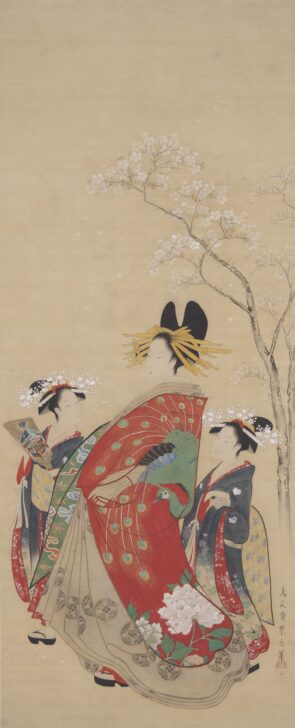Beauty under Cherry Blossoms
Hosoda Eishi

Description
Born of a samurai family, Eishi was appointed to a high court rank. He is known for his tall figures, flowing drapery, elegant line, and bright colors. This painting depicts courtesans in full dress at a flower-viewing festival. An oiran, shown here wearing an overkimono decorated with a peacock flying over peonies, is a high-ranking geisha and she is followed by two kamuro, or girl attendants. The young woman on the left holds a battledore pad while the one on the right carries a cotton ball wrapped with white thread.
Born into a high-ranking samurai family, Eishi first studied the Kanô painting style, the official school of the Tokugawa shogunate and the dominant school of painting in Japan for more than 300 years. It was characterized by an emphasis on brushwork and spare use of pigment.
In 1789, Eishi retired from the honorable position as a “painting companion” of the current shogun in order to devote his career to mastering a quite different style, ukiyo-e, a school of painting and woodblock printmaking catering to popular tastes and often rendered in exceptionally vivid pigments. Here, the artist depicted a courtesan flanked by two attendants in the annual spring promenade in the pleasure district. The medley of beautiful women, the gorgeous tapestry of their garments, and the cherry blossoms is like a glimpse of paradise.
(Label for UMMA Japanese Gallery Opening Rotation, March 2009)
Subject Matter:
Traditionally the famous beauties of the Yoshiwara entertainment quarter in Edo would parade under the cherry blossoms every spring in the newest fashions. Here we see an unknown courtesan (but probably one of the top courtesans at the time) accompanied by two young attendants in matching costumes. The battledore pad and ball were originally used in courtly games (the ball is for kicking), but here they are perhaps attributes to the elegance that the courtesan evokes.
Physical Description:
This is a portrait of a courtesan and her two attendants. The courtesan wears a red cloak with a peacock flying over peonies and a pale green color kimono with “shippô” (seven treasures) pattern. Her green obi, tied in the front, has design of red and blue clouds with gold plants. She is turning away from a viewer to show the gorgeous cloak. Her hair is sculpted in a butterfly shape on the top and has wings to the side. Tortoise-shell combs and multiple hairpins adorn the hair. Her two attendants flank the courtesan; they wear matching, dark green kimono with chrysanthemum flower design and red underkimono. Their kimono have especially long sleeves (furisode), whose openings are tied with ribbons. Their obi are in brocade and tied on their backs. Their hair is sculpted in round shape on their tops and has side wings like the courtesan. They wear silver hair accessories of cherry blossoms and tassels, long hairpins and red silk ribbons. The attendant on the left holds a battledore pad and the right attendant holds a ball. All the women wear black platform sandals. There is a cherry tree in full blossom on the right, from which some petals fall on the women and the ground. There are the artist’s signature and seal on the lower right corner. It has mounting of beige silk and two strips of floral pattern brocade on the top and bottom of the painting.
Usage Rights:
If you are interested in using an image for a publication, please visit https://umma.umich.edu/request-image/ for more information and to fill out the online Image Rights and Reproductions Request Form.